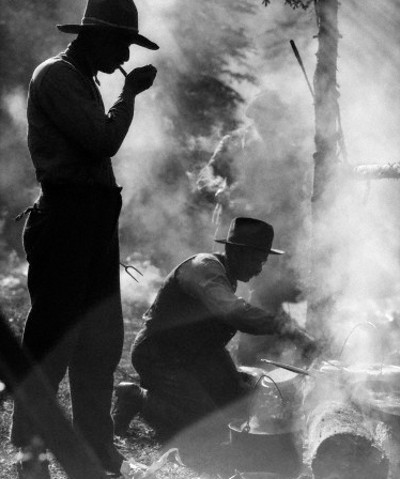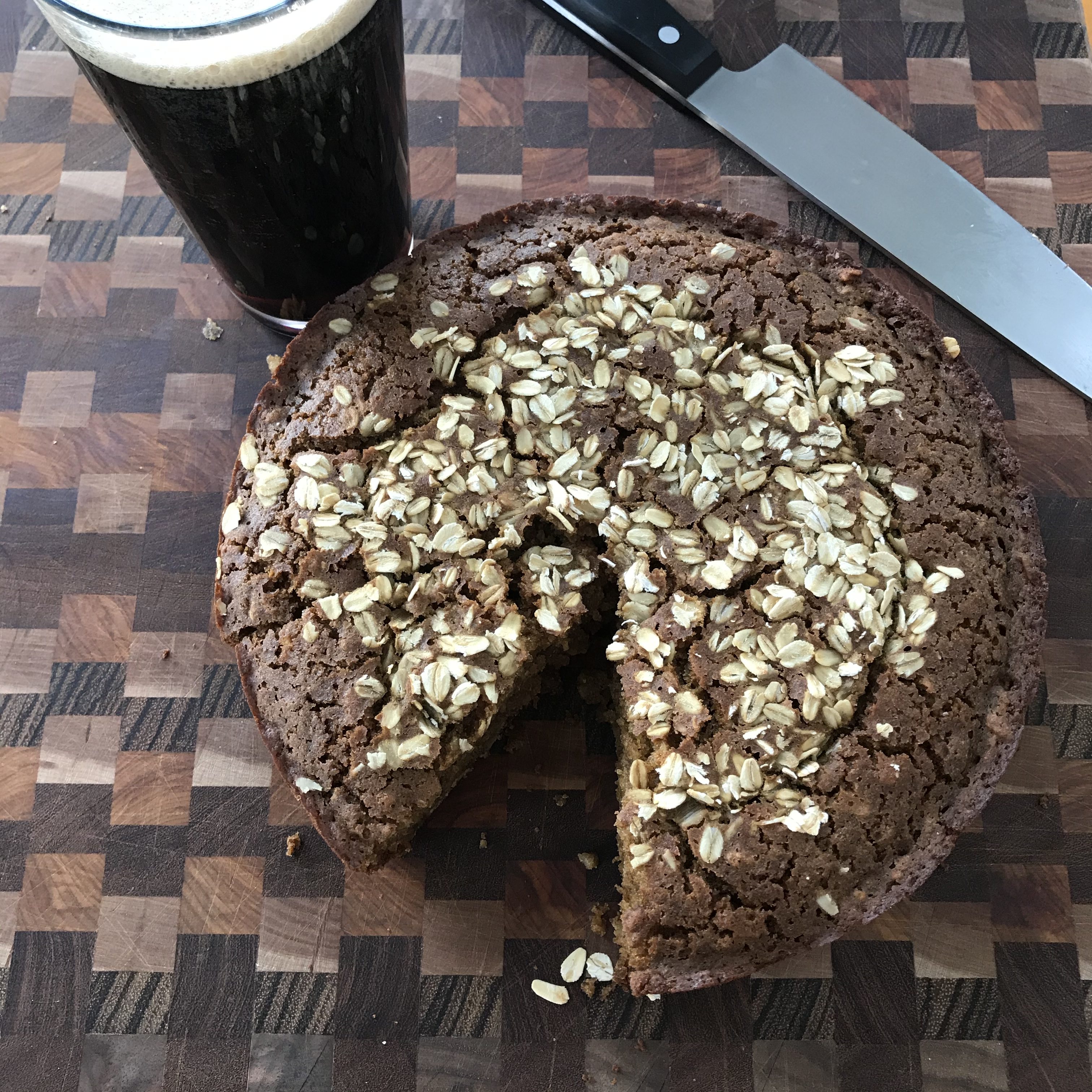
One of the easiest ways to streamline your camping trips (and thus make them more frequent) is to eat meals that don’t require any cookware, preparation, or clean-up. Enter stick cooking. With only your simple provisions and a rod of wood, you can make a tasty snack or meal. Stick cooking isn’t just enjoyable for outdoor expeditions either, but makes for a fun time when you have friends and family over to sit around your backyard fire pit. Finally, nothing tastes better or feels more satisfyingly primal than cooking your edibles over an open fire and living flame to mouth.
You’ve probably cooked a marshmallow on a stick before, but there are other options to explore as well. And even your marshmallow roasting technique could likely use some improvement!
Making the Fire
All stick foods cook best over a bed of hot coals, rather than stuck directly in flames. So plan to build your campfire about an hour before you’d like to eat, giving the kindling and logs time to burn down into embers. You don’t always need to build a roaring campfire (although they’re quite satisfying); sometimes a small cooking fire will do.
Once the fire has been going for awhile, you can roast your foods by placing your stick over the coals that spill out from the fire, or by threading your stick through openings in the logs that give you access to the coal bed. If the openings aren’t sufficiently convenient, push the fire over a little to expose a patch of embers.
Choosing Your Stick
While your fire gets going, search for your cooking stick. It’s the only utensil you’ll be employing, so make it a good one. Find a stick that is long enough to enable you to sit far enough from the fire to not be scorched as you cook, and sturdy enough that your stick won’t droop and release its precious cargo into the flames. Greenwood sticks generally work best, as they’re less likely to catch fire and burn through.
After you choose your stick, whittle off the bark on the end so you have a nice, smooth, clean area and a sharp tip with which to impale your victuals.
Your Gourmet Stick Menu
1. Hot Dog
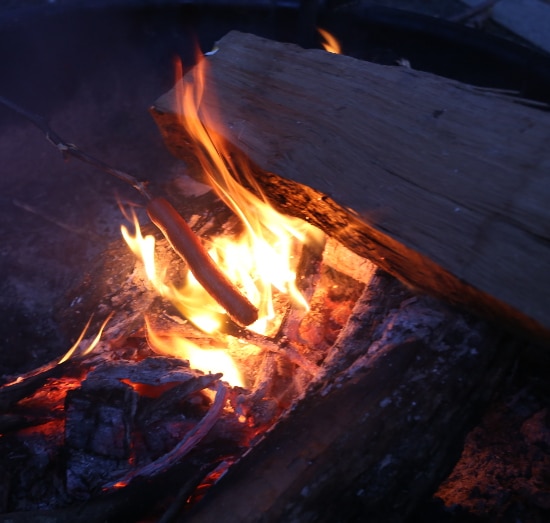
I’ve run into a surprisingly high number of men who have never roasted a hot dog on a stick. Which is a shame, because though there are as many ways to cook a wiener as there are to skin a cat, fire-roasted is unarguably the tastiest. Cooking this meal is the simplest of all the stick foods as well; just impale that wiener and hold it over the embers or even place it straight into the flames. Hot dogs are quite resilient; they’re hard to burn or “flame out.” Just heat and eat.
If you haven’t had a weenie roast with friends, you haven’t been livin’.
2. Biscuits/Bread
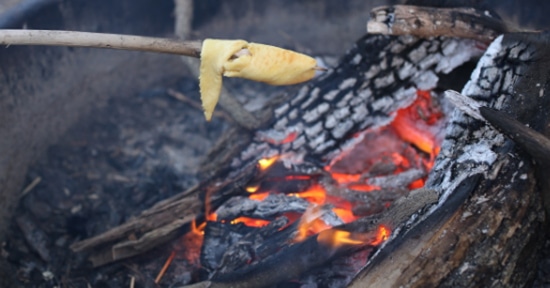
Baking bread on a stick is a tradition that goes back at least a century, and being proficient in this skill was in fact one of the requirements for earning the Boy Scout cooking badge back in 1911. Back then, you had to make your own dough from scratch, and doing so today, even in the woods, is surprisingly easy. (Check out this post on bannock bread for the recipe.) But for the lazy, like yours truly, you can simply start with a can of refrigerated biscuit or crescent roll dough. The latter comes ready in thin strips and is easiest to wrap around a stick; if using circular biscuits, flatten them until they’re about ¾ of an inch thick. Wrap the dough around the end of the stick, firmly pinching the sides together. Slowly roast it like a marshmallow, turning constantly until golden brown. Patience is your friend here; if you try to hurry things up by holding it too close to the embers, the outside will quickly burn, leaving the inside gooey and undone.
Once fully cooked, eat it plain or place sausage, butter, or jam inside. You can also take biscuit dough and wrap it around a hot dog for a pig in a blanket on a stick.
3. Bacon

There’s no occasion where bacon is an unwelcome guest, and camping is surely no exception. In fact, scientists* have found that bacon tastes its very best when eaten in the great outdoors. You don’t even need a frying pan to whip some up in the morning. Just wrap a piece around a stick (if the stick has a couple nubs for traction, all the better), and hold it over the fire. Bacon burns and chars easily, so while you’ll be eager to get that delicious strip in your mouth, take it slow.
*Scientists = yours truly conducting rigorous, regularly duplicated experiments in eating bacon in various locales.
4. Grilled Cheese

Where the bread rests on the fork of the stick will obviously not get toasted. If it bothers you, you can shift the sandwich around to brown the untoasted spots.
Grilled cheese is the ultimate comfort food, so why not have Mother Nature whip you up one while out in the woods? You’ll need a special stick for this endeavor — one with a fork on the end. The fork must be wide enough and long enough to be able to securely balance a piece of bread. Put together the traditional grilled cheese set-up by buttering (butter spray is quite convenient) two slices of bread and sticking two slices of cheese between them. Then rest your sammy on top of the fork. Toast the sandwich. When the bottom slice is brown, carefully flip over the sandwich and toast the other side. Take it slow, or you’ll toast the bread before the cheese has melted.
5. Egg

Eggs are part of the advanced school of stick cookery; do not attempt until you become practiced in roasting the easier foods. We tested out a variety of methods, and lost almost a dozen eggs before we finally had success. The experiment was quite fun though; almost like that competition in school where you have to rig up a box that will allow you to drop an egg from a ladder without breaking it!
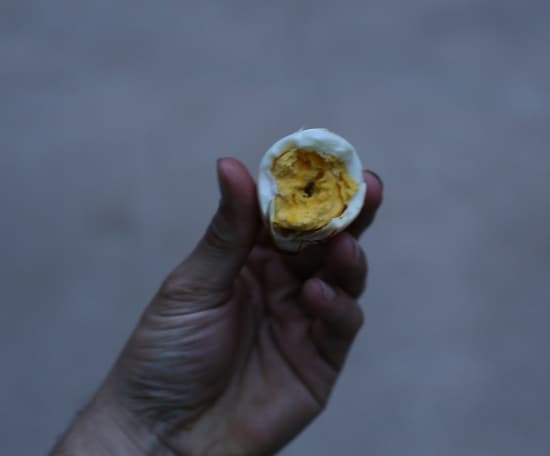
The cooked egg.
The key for successfully roasting an egg is the stick you choose. It has got to have a Goldilocks-esque ratio of girth and strength: thin enough to fit through two small holes in an egg, and yet sturdy enough to support that egg as it cooks. Once you’ve procured this stick, hold the egg horizontally, and carefully make two small holes on both tips of the egg with the point of your pocket knife. Gently thread a thin stick through the hole on the wider end and out the hole of the narrower end. Keeping the egg level, roast it over the coals, turning to ensure even cooking. When the egg becomes difficult to pull off the stick and egg white ceases to leak from the holes, it’s done and ready to be eaten. Allow it to cool, and then peel it like you would a hardboiled egg.
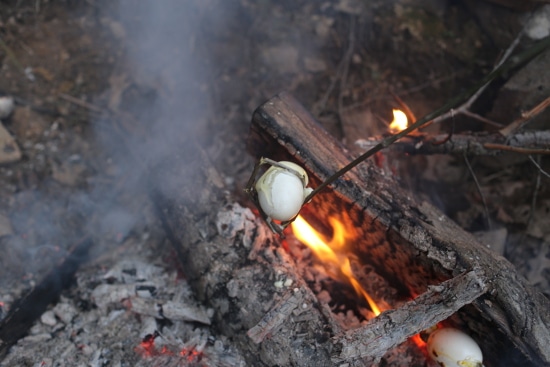
My brother-in-law, who is an engineer, rigged up this apparatus which also met with success.
You can of course roast an egg directly in the coals, by puncturing a hole on top (without this hole, it’ll explode), and placing the egg upright in the embers. The downside of this method is that you still need to turn it for even cooking, and yet the egg gets extremely hot, so doing so, without tipping the egg over, is quite difficult. It’s also not nearly as fun as cooking an egg on a stick, which I will admit, when you nail, really makes you feel like a boss.
6. Marshmallow
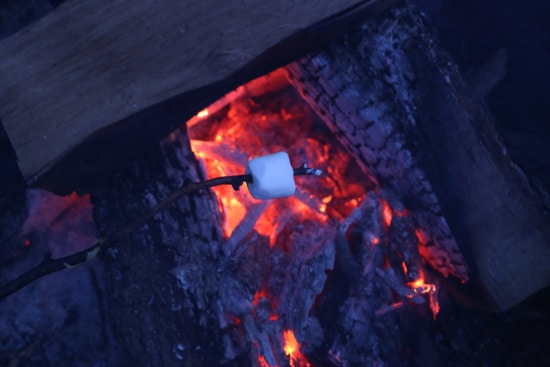
Just because it’s common, doesn’t mean it’s commonly done well. Too often marshmallow roasters, understandably eager to assemble their s’more, will rush the cooking process, and impatiently thrust the delicate white pillow directly into the fire, quickly charring the marshmallow in a crude “flame out.” There are those who claim they like their marshmallow black and crispy, but I have to believe such claims are rooted in cognitive dissonance.
To cook a marshmallow properly — golden brown and slightly crisp on the outside, hot and gooey on the inside — look for a little “cave” of coals within your fire and place your marshmallow over it. A great tip I picked up from the book Cooking With Fire by Paula Marcoux, is to place a piece of wood in front of the opening. This creates a mini oven of sorts, and creates a fulcrum upon which you can rest your stick and turn it evenly. If you find that your marshmallows are turning out done on the outside, while the inside is still raw, Marcoux recommends giving them some preliminary cooking in a cooler part of the fire, before finishing them in your hot box.
Once your marshmallow is golden brown, sacrifice it upon the graham cracker altar, and give thanks for the forces that brought the incomparable s’more to man.





